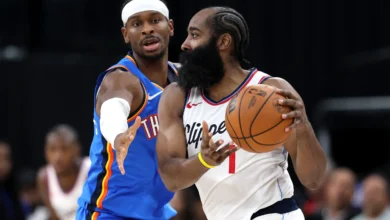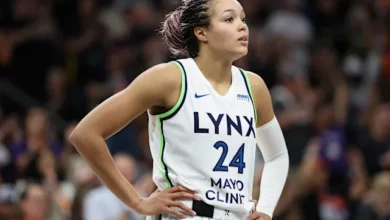Why the Maple Leafs should still be a dangerous offensive team this season

Will the Maple Leafs score enough this season?
It’s a question I’ve seen out there frequently in the offseason and so far in training camp. And it’s probably a fair one. Last season, they scored 31 fewer goals than the year before to fall to 3.26 goals per game. Then they lost a 102-point player in the offseason.
Mitch Marner has been replaced by three veterans who have largely been third liners in their careers. And an eight-goal scorer from last season currently on the top line is filling in for another eight-goal scorer who is the only other candidate to play with Auston Matthews and Matthew Knies.
Panic time?
Something about the idea that this team won’t be able to score doesn’t sit right with me, however. So I wanted to try to dig into the question a little bit more, statistically, and see what the data might tell us about this lineup and what it should be capable of.
Is it simple math? Drop a first-line player; fail to add another top-six forward; take a step back? Or could the Leafs find more places from which to draw offence?
To get us started, I pulled together some numbers on the basics. How many goals did the players currently set to make the Leafs roster score last season? How many have they scored historically? What are likely totals for them this season? And what does that all add up to?
The “average” column above is simply averaging last year’s goal total with the player’s career average per 82 games, and I’ve sorted by that rough number to give us a very baseline projection of the Leafs’ most dangerous offensive players.
You can definitely quibble with some of the calculations — William Nylander’s number is dragged down from the early years in his career, while Calle Järnkrok’s is dragged up, etc. — but what I was really looking for was just a basic outline of how these players have produced goals.
If you add up the columns, the players listed here scored 265 goals last season, have averaged 315 per 82 games in their careers, and the average works out to 290 goals as a group.
Per 82 games, that’s 3.23 goals per game (which would have ranked 10th in the NHL last season), 3.84 goals per game (which would be first by a lot) and 3.54 (second).
It’s not the profile, in other words, of a team that isn’t going to be able to produce offence.
One thing that stands out when you do a deeper analysis of these numbers is just how many of these players had uncharacteristically poor seasons last year. Matthews is an obvious one, given his injury issues held him to nearly 20 goals below his per-82-game average, but five others were down substantially from their career averages, including Max Domi, Matias Maccelli and Dakota Joshua. (Järnkrok and Oliver Ekman-Larsson are the others, but a chunk of their decline is age- and opportunity-related.)
The only Leafs who substantially overperformed their career averages last season, meanwhile, are Nylander and Knies, but it’s certainly plausible that those two can combine for 70-plus again as their new normal.
Overall, the Leafs as a group were down 50 goals total from their career per-82-game average. Thirty-eight percent of that was Matthews, which is obviously a huge factor in the equation of trying to project where Toronto will fall this season.
If he’s a 60-goal man again, it’s a game changer. Even scoring 50 would be a significant boost from last season and replace a lot of the goal production Marner provided.
Domi, Maccelli, Joshua and Järnkrok, meanwhile, combined for just 24 goals after scoring 54 as a group in 2023-24. Simply with better health (Joshua and Järnkrok) and opportunity (Domi and Maccelli), they should have more to give, even if it’s not another 30.
The other area the Leafs could potentially get a goal boost is from the back end.

Morgan Rielly and the Leafs’ defence could help improve the team’s fortunes offensively. (John E. Sokolowski / Imagn Images)
Toronto finished last in goals from the blue line a year ago, with just 21, and last by a lot in percentage of goals scored by a defenceman (7.9 percent). Colorado ranked first with 54 goals and 19.8 percent.
Some of this is personnel, as Toronto’s “Tree-fence” is built around GM Brad Treliving’s predilection for big, stay-at-home types who can defend the way head coach Craig Berube wants them to.
And, generally speaking, you’re not getting a pile of goals from skating trees.
That said, as a group, the Leafs defence was down 16 goals last season versus their career average. They should be able to count on a bit more offence from the defence, especially considering those blueliner goals started to come in the postseason, when the Leafs led the NHL in percentage of goals from the back end (22.2 percent).
Some of that will be on the coaching staff to find more ways to activate Toronto’s D. Too often under Berube in his first season, the Leafs were guilty of having a lot of one-and-done chances in the offensive zone and failing to maintain pressure. Establishing more of a cycle and using their D to create offence — especially from Morgan Rielly and Ekman-Larsson — is going to be key.
When I go through the Leafs lineup player-by-player and project a goal total for them for 2025-26, I come up with around 270 goals, which would put them just shy of high-scoring, top-five teams like the Stars and Jets last season. Getting more goals from Matthews, the newfound depth on the wing, and a few more bounces from the point should add up to a healthy total, assuming the Leafs don’t have a catastrophic run of injuries or an implosion on the power play.
It’s worth remembering the Leafs finished seventh in scoring a year ago despite a deep run of forward injuries early in the year — they ultimately lost $7.3 million in forward salary to injury throughout 2024-25, one of the higher totals in the league — and regularly deploying a fourth line centred on David Kämpf and Ryan Reaves that was never going to produce offence.
Part of the rosy outlook for their goal production involves keeping Nick Robertson and Järnkrok and playing them a regular shift, something that remains up in the air early on in training camp.
And it’s also fair to expect there will be (a) some adjustments made by Berube to try and improve things like offence from his defence and (b) a midseason addition from Treliving aimed at bolstering the top line at right wing.
It’ll be interesting to see how this plays out given they’ve subtracted such a key cog from the offence. But as the numbers show here, going from a Core Four to a Key Three shouldn’t lead to a dramatic falloff for this group.
There appears to be enough proven scoring ability in place to prevent that.
(Top photo of William Nylander: Mark Blinch / NHLI via Getty Images)



